Lensun MPPT has to be isolated from frame
Maybe. I posted last month about deciding which MPPT controller to install on my trike:
- MPPT controller for custom trike — September 13, 2024
...chose the Lensun. I very much doubt the Lensun company claim that it is both a buck and boost controller, as it says nothing in the documentation supplied with the controller, other than it is a boost controller. The Lensun website shows a photo with the front panel in English; however, the one that they sent me has Chinese characters on the front panel and Chinese User Manual. Here is the manual:

Page two:
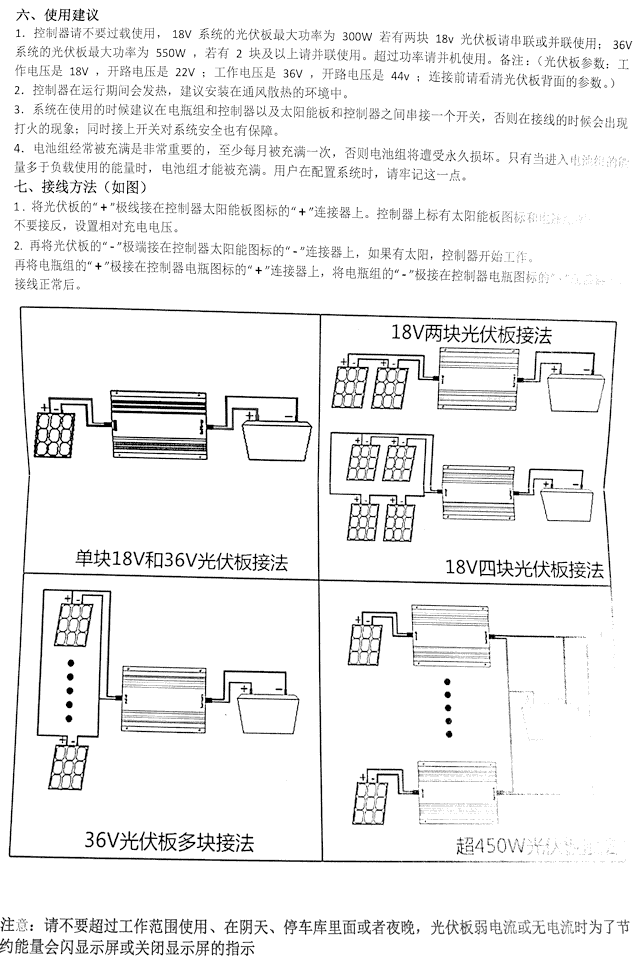
I figured out basic usage. In the above table, you can see the value "58.4" -- that is for a nominal 48V LFP battery with 16 cells. That is what the charging voltage has to be set to. I already knew that, and figured out that the "+" and "-" buttons have to be held down together to put it into output-voltage-setting mode, then the "+" and "-" buttons can be used to set the voltage.
As can be seen in the earlier blog post, installed it on the trike, bolted underneath the solar-panel frame.
All seemed good, until a few days ago I was able to translate the manual to English. EasyOS has gImageReader, installable via PKGget (only recently added to the repository, see blog post). This is an OCR (Optical Character Recognition) app, which produces output as Chinese text. I then fed that to translate.google.com and got English.
It is all OK, except for this paragraph:
5. When installing this controller, it is best not to install the controller directly on the metal bracket.
...very interesting statement! My guess is that the power switching transistors are bolted to the controller heatsink frame with electrical-insulation. In ye olden days, this might have been a thin sheet of mica. It might be that they are not guaranteeing this isolation, hence covering themselves with the above statement.
Or, maybe they have only made that statement to reduce vibration.
Anyway, I decided to remount the controller isolated, on a small piece of plywood. Used plywood intended for internal use, so painted it for some external protection. Only two spray cans to choose from; black or red enamel. Choose red. Intended for metal, but reckon OK on the plywood. Put on three coats. Here it is mounted:

...quite easy to remove, convenient for testing the other controllers.
Ah yes, removal. First time bolted on, I used Loctite (medium strength) and locknuts. Only m4 bolts, but just about impossible to undo. Have used this combination all over the place on the trike, but as I discovered, the combination of Loctite and locknut is just too much. Got them undone, but was amazed that the bolts didn't sheer.
Those bolts are good quality. I bought plastic flip-top boxes of assorted lengths of bolts/nuts/washers and allen-key from Aliexpress, very handy. Bought m4, m5, m6, m8 boxes. They are 304 stainless steel -- that is not "marine grade".
The complete English translation is here: page 1,
page 2
In the previous blog post, I mentioned a MPPT controller on
Aliexpress that looks like the Lensun, but a fraction of the
price. Yeah, I couldn't resist. Bought it ....and it looks
identical to the Lensun. Don't know about internally. Do plan to
test my collection of MPPT controllers on the trike sometime in
the future.
Tags: light
Custom trike luggage rack completed
Continuing the custom recumbent trike project, here is the previous post:
- MPPT controller for custom trike — September 13, 2024
The rear luggage rack was originally bolted directly onto the wheel fork, but I moved it up above the shock absorber. This photo shows that the bottom of the luggage rack is now bolted onto thick (5mm) aluminium bars, one each side:

There will be panniers on the sides of the luggage rack, and to strengthen the rack framework, see the short lengths of aluminium tube that have been mounted horizontally. These will help to prevent the panniers from pushing the luggage framework in toward the wheel.
The two vertical black tubes are to support the solar panel. They are 22mm OD. Those 90-degree pipe clamps are available from Aliexpress:
https://www.aliexpress.com/item/1005007097452540.html
The vertical black tubes have been reinforced with diagonal aluminium tube. The pipe clamps are 22mm with rubber strips, available from here:
https://www.aliexpress.com/item/1005002813162527.html
...I bought those because they have double-thickness tabs, where the bolt goes through, which I think assists with clamping tightly. Photo of smaller 8mm clamp:
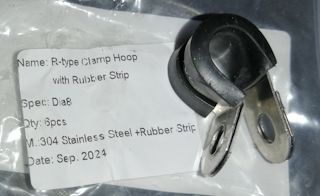
The smalled clamps on the luggage rack frame are the ones shown in the above photo, and I removed the rubber. The luggage frame is tubes about 10-11mm, and the 8mm clamp is a good tight fit.
The wood blocks bolted to the seat may or may not be temporary, depending in whether I need to adjust the seat position.
in the photo, notice the large black rubber cap on the end of the 55mm OD pipe. This is to keep out the rain. It is 50mm, that I was able to stretch over the pipe. Purchased from here:
https://www.aliexpress.com/item/1005005239973627.html
The custom trike project is progressing slowly, as busy with
other things, especially EasyOS and QV coding. But, it is
progressing.
Tags: light
MPPT controller for custom trike
The custom recumbent tadpole trike project cotinues. Here are recent blog posts:
- Surprising stability of solar-powered bicycle — August 29, 2024
- Custom trike rear extension — August 23, 2024
- Chain installed on recumbent trike — August 12, 2024
- Solar panel frame for trike take-2 — August 09, 2024
...that last post describes the frame on which the solar panel will be affixed. There is now framework underneath on which to attach the MPPT battery charge controller.
The voltage from the solar panel is lower than the LFP battery,
requiring a "boost" controller. This is the opposite of a "buck"
controller, which is for charging a battery with lower voltage
than the panel. The solar panel is nominally "24V" and the battery
"48V" LFP.
Over the years, I have bought a lot of these controllers, both types. I have tested buck controllers that claim to be MPPT, but aren't. MPPT means "Maximum Power Point Tracking"; the peak power point, that is, the voltage and current, out of a panel varies with temperature and insolation (light intensity). That peak power voltage and current drops as temperature rises; I don't have figures off the top of my head, but I recall about 0.5% power drop for each 1 degree Celsius rise.
Over the last couple of years, I have purchased four boost
controllers, and had the intention of doing a comparison test, but
never got around to it. Anyway, the first one I bought is the
Juntek MPT-7210A:
https://www.aliexpress.com/item/32871591762.html

What raised my suspicions about this controller is that the solar
panel voltage has to be set manually. I searched online and found
a couple of people commenting that this is not a MPPT controller,
despite the claims. Yes, it does track, but it tracks the fixed
voltage; that is not MPPT. I must emphasize though, that I haven't
tested it and have not verified that it is not a true MPPT
controller.
I have three other boost controllers that are genuine MPPT, albeit determined from the specs and reviews, not from personal experience yet. The next one I bought, that I thought would be great for the trike as it is fully sealed, the elejoy 400W step-up:
https://www.aliexpress.com/item/1005005762970289.html

Later on, found another, that I couldn't resist buying, the Lensun 550W buck-boost controller:
https://lensunsolar.com/collections/solar-controller/products/lensun-buck-boost-solar-controller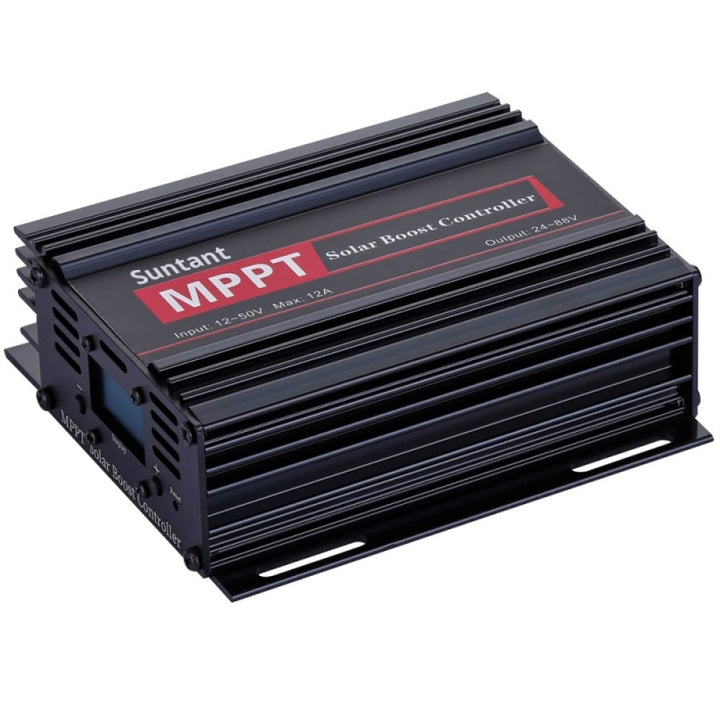
...more expensive than the others; it cost me AU$130 including
AU$25 shipping.
Lensun claim that this is both a buck and a boost controller. As a retired electronic engineer, I know that this is technically possible, but very unusual. Unique at that price. Again though, I must emphasize that I haven't verified the claim.
I have another boost MTTP controller, rated at 600W. Leaving that out of consideration for the trike, as the solar panel is only rated at 200W -- likely only to deliver about 160W based on past experience -- but then, this panel does look like from a reputable manufacturer and actual output might be closer to the rating.
Of the three contenders, only two of them are true MPPT controllers. I have built framework under the solar panel frame so as to be able to mount either, the elejoy or the Lensun. Might get around to comparing them, but for now, have put the Lensun controller on the trike.
A downside of the Lensun is that it is not sealed, so probably
not a good idea to ride the trike while it is raining; at least,
not without affixing some weather protection around the
controller. Though, there would only be a problem with rain
blowing under the solar panel frame while riding.
Yes, the Lensun controller is mounted under the solar panel frame:

...it is mounted so that I can see the front display while seated.
Notice the switch beside the controller; that is to disconnect the solar panel. Probably not essential, but I thought might as well put it in (note, there will be a circuit-breaker between the controller and battery). Yet to be wired up; the black twin cable shown in the photo goes down the vertical tube and to the battery.
Coming along, slowly but surely!
EDIT 2024-09-14:
I posted above that the Lensun controller cost me AU$130. I
wondered if it is available cheaper elsewhere. It seems that
Lensun is a USA company and the controller is manufactured in
China. I found it on Amazon and also another brand, "SolarEnz":
https://www.amazon.com/Controller-Lead-Acid-LiFePO4-Batteries-Electric/dp/B0B74HF4X3
...no mention of it being both buck and boost, nor mention of extended input voltage above 50V. But perhaps the external box is the same and Lensun have purchased it with different internals.
I wondered if it is available direct from China, and made an interesting discovery, this for AU$48 including postage:
https://www.aliexpress.com/item/1005007612832046.html
...notice that some labeling has been
blacked out. Ha ha, I'm very curious, tempted to buy it just to
see what the labeling is. Perhaps it is one of the models
manufactured for a reseller and the vendor doesn't want to show
that.
Tags: light
Surprising stability of solar-powered bicycle
Last year I posted some pictures of electric bicycles with overhead solar panels:
- Solar leaning trike safety concerns — November 17, 2023
That post included this photo:

My thinking at the time was this type of design would be impractical, due to side winds. Well, it turns out I was wrong!
Jack Butler won the 7,000km Sun Trip 2024 on a bicycle similar to the above. Including riding in "gale force" winds. Here is his participant page and a photo of his bike:
https://www.thesuntrip.com/en/participants/jack-butler/
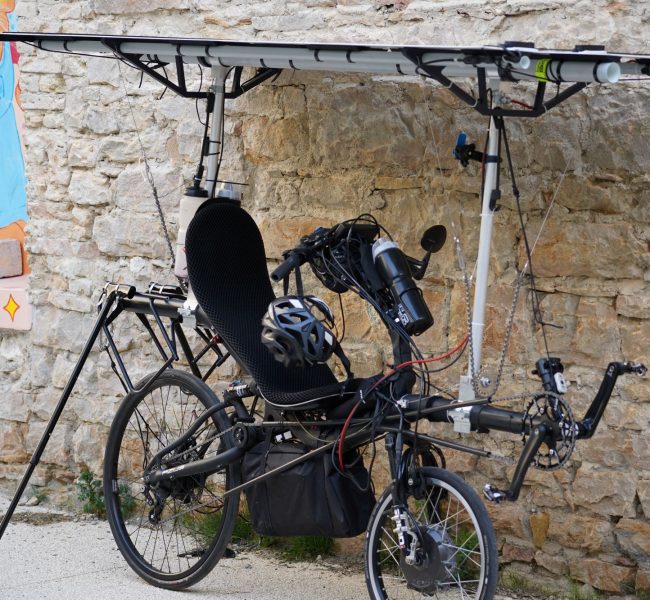
Jean-Marc Dobouloz came second, in a velomobile:
https://www.thesuntrip.com/en/participants/jean-marc-dubouloz/
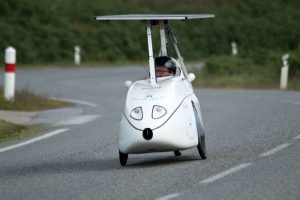
Jack has a YouTube channel and he posted several videos about the Sun Trip challenge. What really fascinated me is that when they hit the "gale force" winds, Jean-Marc was in the lead but his velomobile got blown over, whereas Jack managed to keep going and got into the lead.
This is Jack's post about encountering the high winds:
"The Sun Trip 2024 Day 8 - Fighting for my life in gale winds on
DIY Solar touring ebike"
https://www.youtube.com/watch?v=xsWqHQHJobA
This comment is interesting:
Incredible you managed to stay upright in those winds on two wheels while Jean-Marc with the greater stability of three wheels came a cropper. I wonder if it’s because you can sway and bend a bit with the gusts which he can’t.
Another thing that I wondered about is the attitude of the police when they see Jack's bike. That is also interesting; he only got stopped once by the police, and fined 200 Euros. And that was for holding his phone and wearing headphones!
After the Sun Trip, Jack posted a video describing his bike:
"Unique Touring Bike Review after 7000km with huge solar panel
roof shade"
https://www.youtube.com/watch?v=ZDByoLRS9QA&t=587s
As I am building a solar-powered recumbent trike, I read reports of other projects with great interest. I'm fascinated by the weight of these bikes and trikes, posted here:
https://www.thesuntrip.com/en/les-velos-du-sun-trip-2024/
...Jean-Marc's trike is 74.8kg when empty. That is very heavy. I
wonder if by "empty" they mean fully laden with luggage, such as
camping gear and food, just sans the rider? No, "empty" should
mean just that, no luggage.
Tags: light
Custom trike rear extension
Continuing the custom tadpole recumbent trike project, here are recent posts:
- Chain installed on recumbent trike — August 12, 2024
- Solar panel frame for trike take-2 — August 09, 2024
- Fenders for custom trike — July 25, 2024
The original trike came with a luggage rack; however, that was bolted onto the rear wheel fork. That means, all road corrugations will be transferred directly to whatever luggage is on the luggage rack or side panniers. Also, the effectiveness of the shock absorber is reduced; as much weight as possible needs to be above the shock absorber. So, one requirement was to move the luggage rack mounting above the shock absorber.
The second requirement was framework for mounting the overhead solar panel.
The trike frame has an open end, for possible extension:
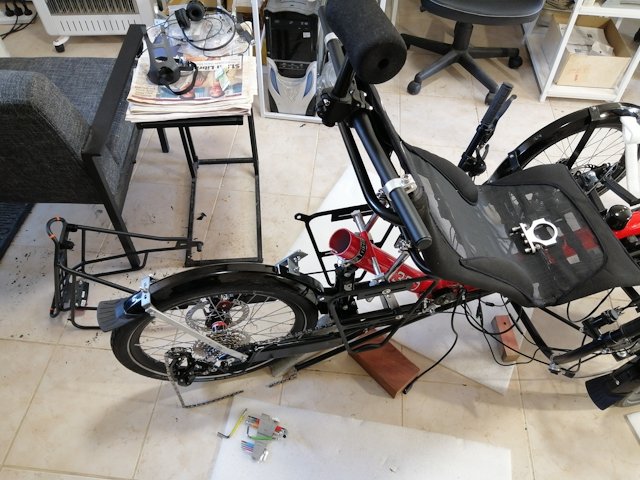
I measured carefully and determined that aluminium tube of 55mm OD could be inserted. So, purchased a 300mm length, 2.5mm wall thickness, from here:
https://www.aliexpress.com/item/1005006996429358.html
Many Chinese vendors will sell tube in OD increments of 1mm and different wall thicknesses. This particular vendor, only 300mm length, but there are others that will sell longer lengths.
Also purchased 22mm OD, 2.5mm wall thickness, 500mm length, from here:
https://www.aliexpress.com/item/1005005177763572.html
Created the extension, with 3mm thick aluminium strap wrapped around the 55mm tube and held in place temporarily with pop rivets:
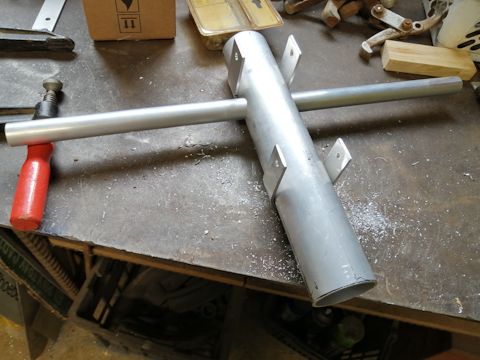
At the workshop I attend, Mal helped me; used the workshop's MIG welder to put some spots of weld to hold it all together. I was then able to hammer the extension into the trike tube, held in place with a pipe clamp and 4.0mm pop rivets:

Made some more pieces of strap to mount the luggage rack:
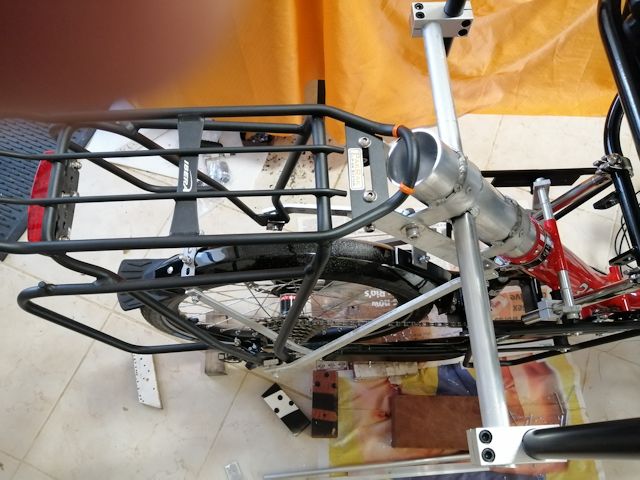
...not quite finished. I'm going to put a couple of lengths of tubing as cross-bracing to make it more rigid.
The 22mm horizontal tube has vertical tubes at each end. This
will be for mounting the overhead solar panel. You can see in the
photo, the vertical tube is black; it is 22mm OD and length 675mm.
I bought it here in Australia and it was rather
expensive.
Tags: light
Chain installed on recumbent trike
Continuing the custom recumbent tadpole trike project, here are the last couple of posts:
- Solar panel frame for trike take-2 — August 09, 2024
- Fenders for custom trike — July 25, 2024
Have now installed the chain. Knowing nothing about bicycle maintenance, watched a few YouTube videos, then tackled the installation...
Photos of recumbent trikes show the plastic tubes that the chain goes through, kind of unattached at the ends. However, at the front, decided to secure them in place, so as more accurately guide the chain onto the sprocket. It would be different if there were multiple sprockets on the front, but this trike only has rear gears. Made a bracket and mounted it:
 |
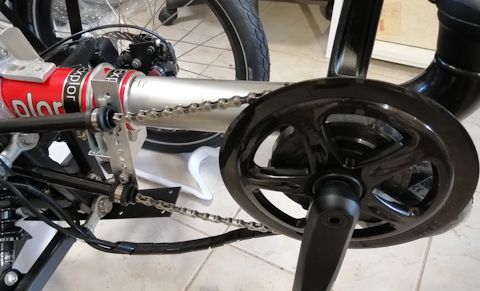 |
...have decided to move that bracket back a bit, compared with first installation shown in the above photo.
At the rear, had to shorten the chain, and this is where the YouTube videos were invaluable. There was, however, a difficulty; just could not get the chain pin out. I have a cheap bicycle toolkit, that includes a chain-breaker tool; however, it would not push the pin out. A bit of online research, found others reporting the same difficulty.
Examining the breaker tool, the thread feed does seem a bit sloppy, allowing the pin to wander off-centre, so it may have been not entirely centred on the pin. This is the toolkit:
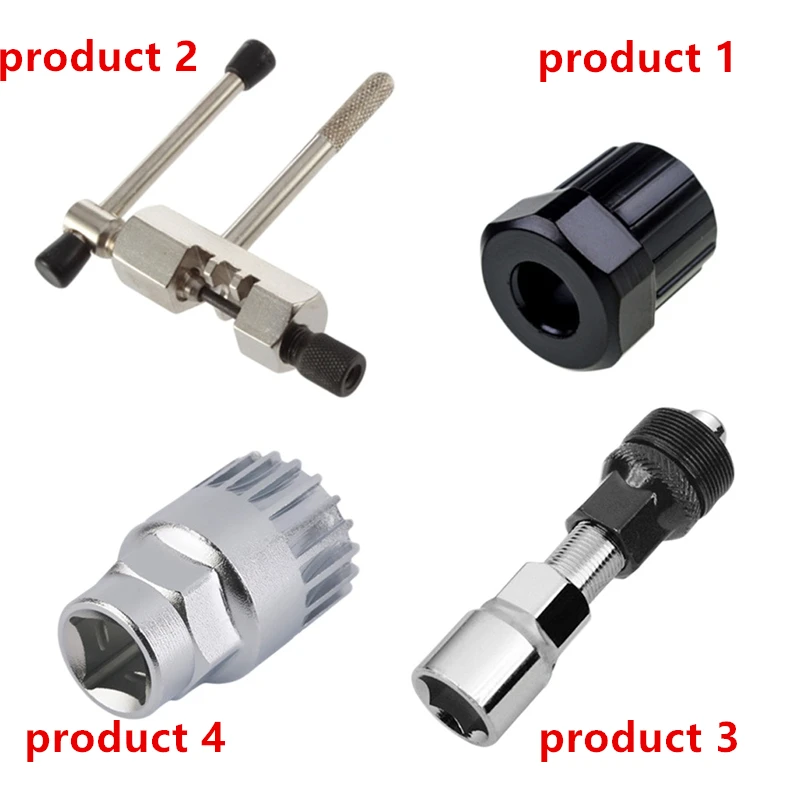
"Product 3" is a crank-puller, already used to change the pedal
cranks from 170mm to 165mm, and it worked OK. Do not yet know what
"Product 1 and "Product 4" are for.
Found another chain-breaker that has good reviews and bought it. This one:
https://www.aliexpress.com/item/1005006113300993.html
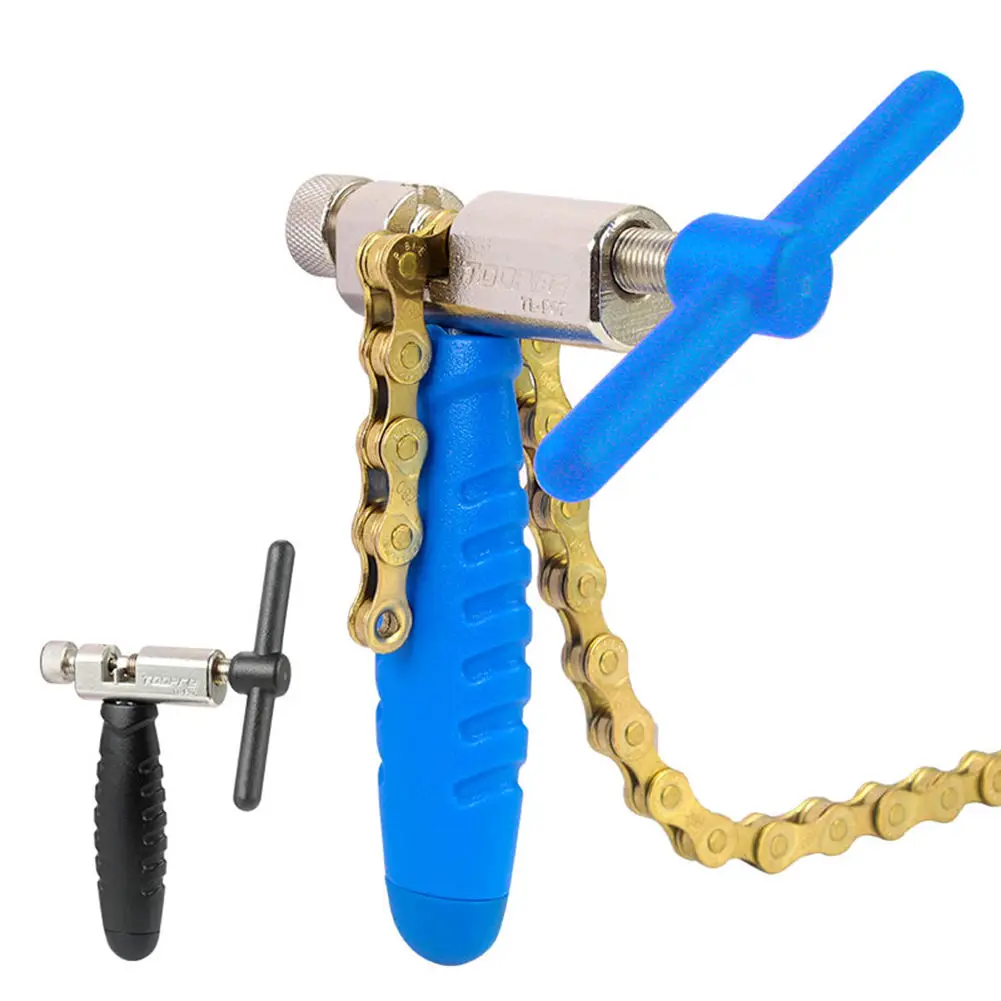
...notice the longer thread. It is also a snug fit, no sloppiness. Easy-peasy, pushed the pin out, no trouble.
The tricky part for this newbie was deciding where to break the chain. Made the decision and used a master-link to join the ends:

...this is on the smallest sprocket. Well actually, the second-smallest. The cassette has 9 sprockets, while the derailleur gears mechanism only has 7 positions, and is setup to move between second-smallest to second-largest sprocket.
Maybe could have taken out a couple more links, but the above
does seem OK. Have not yet tested changing gears to the
second-largest sprocket.
Tags: light
Solar panel frame for trike take-2
About 10 months ago I constructed a frame for solar panels to go on top of the custom recumbent trike project:
https://bkhome.org/news/202310/320e-solar-recumbent-trike-solar-panel-redesign.html
...yeah, I've been working on this trike project that long! Very experimental, so lots of dead-ends. Including the solar panel frame; that design was not very rigid. This time, I have used aluminium square tube, 25.4x25.4mm (1x1 inches), 1.2mm wall thickness. This has been braced with 30x30mm angle, 3mm thick and 50mm 3mm thick flat strap. Got all of this from Bunnings.
Change of plan for the solar panel. The above post states that the allowed width in Western Australia is 660mm; however, in mid-2022 that got increased to 800mm. However, I am limiting to 740mm so as to fit through my front door and motel doors when touring. A local company here in Western Australia, Amptron, had a 24V 200W panel on sale -- I forget the exact price, about AU$320 I think, well below normal retail, so I bought one. That was about 5-6 months ago. Here it is:
https://amptron.au/products/200w-24v-semi-flexible-mono-crystalline-solar-panel/
That's the panel that will now be going on top of the trike. It is "24V" and will charge a "48V" LFP battery, through a boost MPPT controller. The panel is 1600x670mm and here are the pieces of tube laid out on top of the panel:
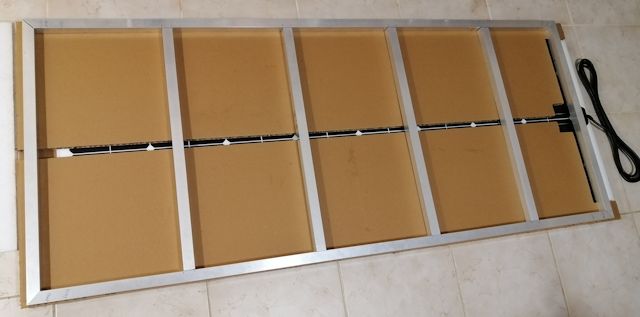
...the gaps between the cross-pieces are 300mm, except at the rear 250mm.
Started by riveting the corners, 4mm pop rivets, with pieces of the 30x30x3 angle:
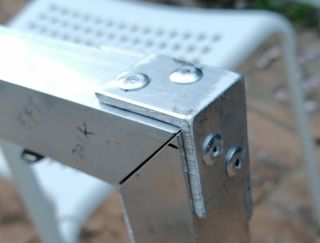
Also riveted angle on the inside, which was a problem as the electric drill chuck is too wide. The workshop that I attend has this handy flexible small chuck that solved the problem:
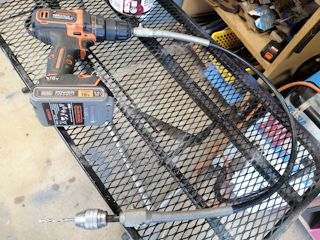
Success riveting the inside:
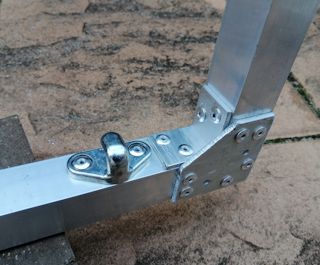
...the photo shows strap riveted on for extra reinforcing. The hook is this one from Bunnings:
https://www.bunnings.com.au/goliath-small-aluminium-fastener-hooks-4-pack_p4230095
I scattered 12 of these hooks around the frame, as convenient for hanging whatever in the future. They are suitable for hanging 12mm (1/2 inch) eyelets, in case want to hang a tent-like weather protection around the trike. Here is the entire frame:
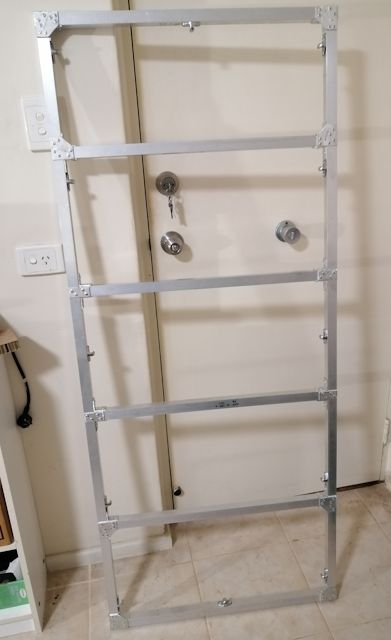
It is very rigid. And light -- on my bathroom scales it is just over 2kg. Good, objective achieved. Also, the vertical poles connecting to the trike will have bracing; though, might only be able to do that at the back.
The frame is not quite finished. There will be brackets to attach
the vertical poles to the trike. Also will probably mount the
boost MPPT controller underneath the solar panel
frame.
Tags: light
Fenders for custom trike
Continuing the custom tadpole recumbent trike project, here are recent posts:
- Foot and leg safety on a recumbent trike — July 10, 2024
- Bash plate for trike — July 09, 2024
- Wheel knuckle modifications — June 29, 2024
The trike came with mudguards (fenders in US English); however, I have to create brackets to mount them in this custom project. Yes, the Wikipedia states that "bicycle fender" is US English, whereas "mudguard" is British English.
As the front now has shock absorber suspension, had to create brackets to hold the fenders:

The rear of the trike came with a tray mounted on the swing-arm, with fender bolted underneath the tray. However, I want the tray, and panniers mounted beside it, to be on the suspended part of the trike frame, not on the swing-arm. It is a basic principle that as much weight as possible be above the shock absorber, not below. So, have to redesign tray and fender mounting.
The fender is still attached to the swing-arm. I used whatever scrap aluminium strap at hand and found mount points the strap could be bolted to:
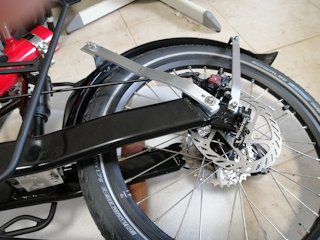 |
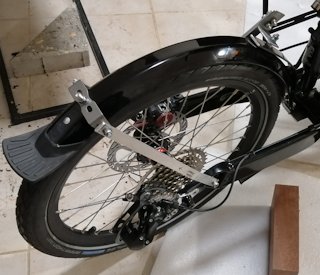 |
...notice at bottom-left of first photo, there is a small
aluminium plate that I riveted to the swing-arm, to attach the
bottom-end of the fender.
There is progress, albiet slowly. Waiting on arrival of a short
length of aluminium tube, 55mm OD, that will slide into the trike
frame and to which the tray can be attached.
Tags: light
